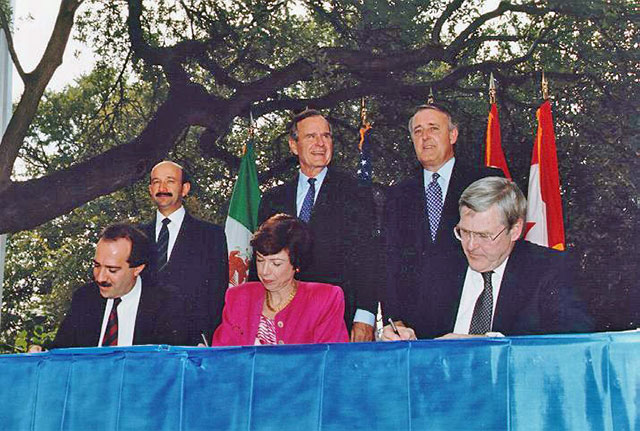
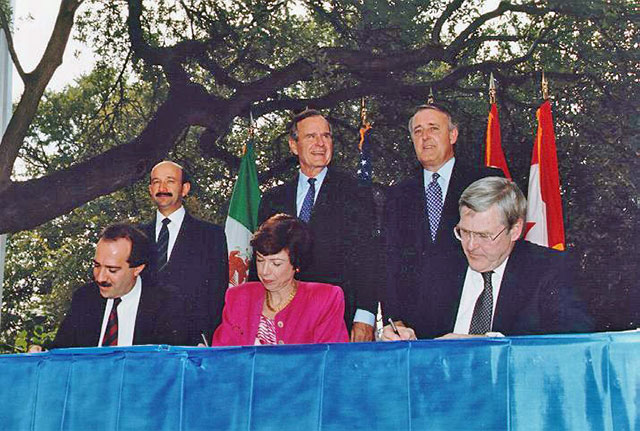 Opening Pandora’s Box: NAFTA Initialing Ceremony, October 1992. From left to right (standing) Mexican President Carlos Salinas de Gortari, US President George H. W. Bush, Canadian Prime Minister Brian Mulroney. (Seated) Jaime Serra Puche, Carla Hills, Michael Wilson. NAFTA’s Chapter 11 provisions unexpectedly opened the door for massive corporate lawsuits that have undermined democracy and environmental protections. (Photo courtesy of UNCTAD)
Opening Pandora’s Box: NAFTA Initialing Ceremony, October 1992. From left to right (standing) Mexican President Carlos Salinas de Gortari, US President George H. W. Bush, Canadian Prime Minister Brian Mulroney. (Seated) Jaime Serra Puche, Carla Hills, Michael Wilson. NAFTA’s Chapter 11 provisions unexpectedly opened the door for massive corporate lawsuits that have undermined democracy and environmental protections. (Photo courtesy of UNCTAD)
A host of international trade treaties and agreements are now being negotiated globally, many of which, say critics, stand to enrich investors at the expense of the environment and democracy by exposing member nations to the Investor-State Dispute Settlement system, better known as ISDS. Jen Huizen explains how an alliance of investors, corporations, and lawyers gamed the system; used NAFTA’s Chapter 11 investment provisions to tip the playing field to their advantage; and repeatedly won against governments, citizens, and environmentalists.
By the time NAFTA (the North American Free Trade Agreement) went into effect on January 1, 1994, the foundation for an environmental policy firestorm had been laid.
The agreement, say NAFTA critics, included investment provisions that inherently created an uneven playing field, allowing corporate investors to directly sue national governments for mega-millions and ultimately sidestep domestic environmental laws. ISDS, the Investor-State Dispute Settlement mechanism, established in 1966, isn’t exclusive to NAFTA, but is built into thousands of trade agreements. And as discussed in Part One of this Mongabay series, ISDS wasn’t originally meant to be the weapon of mass environmental destruction that many experts say it has become.
In fact, some, like former US Trade Representative Carla A. Hills, still claim ISDS provisions are still key to maintaining global trade order: “Dispute settlement systems are in all US trade deals because without [them] the law of the jungle ensues,” said Hills. “You need a system to keep investors and countries responsible to the global economy.”
But while some system for mediating international trade disputes is clearly needed, the onset of gigantic corporate lawsuits — many of which carry major threats to the environment and national sovereignty — has raised a question in NGO circles: if free trade can’t be fair trade, why keep playing at a rigged game?
 The 1999 World Trade Organization protest in Seattle, Washington. NAFTA and other international trade agreements have sparked planet-wide demonstrations, as citizens reject what they see as corporate abuses of democracy, the environment and Indigenous cultures. (Photo by geraldford licensed under the Creative Commons Attribution-Share Alike 2.0 generic license)
The 1999 World Trade Organization protest in Seattle, Washington. NAFTA and other international trade agreements have sparked planet-wide demonstrations, as citizens reject what they see as corporate abuses of democracy, the environment and Indigenous cultures. (Photo by geraldford licensed under the Creative Commons Attribution-Share Alike 2.0 generic license)
NAFTA Ups the Stakes
With its ratification, NAFTA became the first trade treaty or agreement ever to include direct environmental stipulations, added on as an afterthought to quell fears over NAFTA Chapter 11 investment provisions — which the United States touted as a necessary tool to protect US investors from the risk of corruption and destabilization in Mexico. Instead the provision fast became a lucrative tool for companies to sue state governments, something that rarely happened in the past.
Chapter 11, say trade experts, was a Pandora’s Box that once opened, unleashed the true untapped power of ISDS. Corporate attorneys have come up with creative new ways to play the system, building up a whole new litigation industry, capable of vastly increasing corporate leverage and ultimately, bypassing domestic law and environmental regulations.
Some parts of the tale of precisely how NAFTA awoke the ghost in the machine still aren’t completely clear today — many early cases lack publically accessible documents and those involved are still legally excluded from discussing details. And in typical commercial arbitration fashion, dispute cases are often shrouded in secrecy and conducted behind closed doors.
Many early NAFTA disputes didn’t amount to much —withdrawn, dismissed or settled outside arbitration. But it didn’t take long for lawyers and corporations to realize the outlandishly high payouts possible in ISDS arbitration.
“I would never attribute intent to those who fought for NAFTA’s Chapter 11 provisions. I truly don’t believe they had any idea of the impact of their decision. I would however, call this a case of neglect,” said Todd Weiler, an investment treaty arbitration expert. “I think most people simply failed to consider that the system wasn’t just geared towards settling disputes with Mexico, and very soon, came to find it wasn’t a one way street.”
Bill Waren, Friends of the Earth US’s senior trade analyst, said when NAFTA was signed even those worried about Chapter 11 provisions didn’t quite have their heads around the potential power, or reach, of the dispute system. “The last two decades have been a massive, and nearly unrelenting wake-up call,” he said.
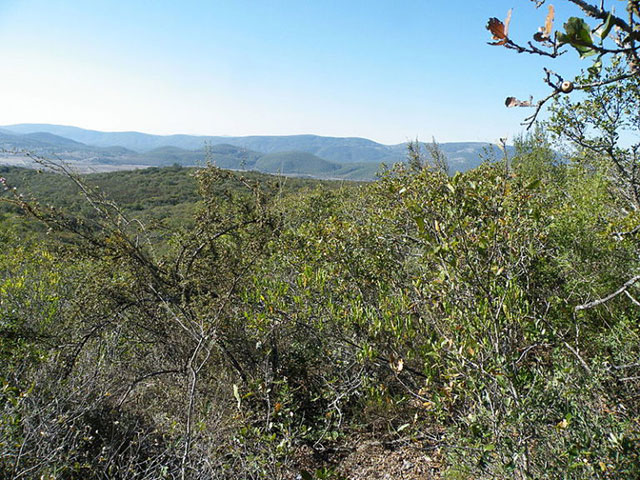 The northeastern municipality of Guadalcazar, Mexico, in the state of San Luis Potosí. It was Guadalcazar’s decision to require, then reject, a municipal permit for the operation and expansion of a hazardous waste facility that sparked Methalclad’s 1997 NAFTA Chapter 11 ISDS case. (Photo by Amante Darmanin licensed under the Creative Commons Attribution-Share Alike 2.0 generic license)
The northeastern municipality of Guadalcazar, Mexico, in the state of San Luis Potosí. It was Guadalcazar’s decision to require, then reject, a municipal permit for the operation and expansion of a hazardous waste facility that sparked Methalclad’s 1997 NAFTA Chapter 11 ISDS case. (Photo by Amante Darmanin licensed under the Creative Commons Attribution-Share Alike 2.0 generic license)
NAFTA: The Early Years
The first few recorded NAFTA dispute cases were brought against Mexico in 1995, and while they didn’t directly impact the environment, lawyers began to experiment with the rules and explore new ways the dispute game could be played. American investors from Amtrade International, a global supply chain company, sued Mexico for US $20 million citing discrimination during a bid for property. The Halchette Corporation launched another suit, for which the details have never been released. Both cases were settled without arbitration.
Mexican investors, lawyers, and corporations — realizing that NAFTA disputes could be a two way street — soon jumped into the action. In 1996, the Mexican generic drug manufacturer Signa SA brought a case against Canada, claiming the country’s “Notice of Compliance” regulations unfairly deprived the Mexican company of Canadian sales of their drug ciprofloxacin hydrochloride, better known to traveler’s with upset stomachs as cipro.
Signa raised the ISDS awards bar substantially, asking for CA $50 million in damages. This case was dropped before reaching formal arbitration too, but the threat of arbitration and the lure of lucrative payouts were slowly but surely attracting more players to the NAFTA settlement system.
In 1997, came the first major NAFTA dispute that on the surface dealt with the environment. American waste management company Methalclad Corporation sued Mexico after regional authorities refused to grant the company a permit to run a hazardous waste facility in an area set aside as an ecological preserve. Like Signa, Methalclad upped their ISDS awards ask, initially filing for US $90 million in damages.
 Greenpeace members handcuffed together and sitting on steel drums similar to toxic waste drums outside of the Mexican Office of Environmental Protection, calling attention to the toxic waste disposal facility at Guadalcazar, San Luis Potosi, owned by the US company Metalclad Corporation, Mexico City, Mexico, July 19, 1995. (Photo compliments Greenpeace Mexico)
Greenpeace members handcuffed together and sitting on steel drums similar to toxic waste drums outside of the Mexican Office of Environmental Protection, calling attention to the toxic waste disposal facility at Guadalcazar, San Luis Potosi, owned by the US company Metalclad Corporation, Mexico City, Mexico, July 19, 1995. (Photo compliments Greenpeace Mexico)
Though not involved in the Methalclad case directly, Todd Weiler, someone who’s watched the system transform over his career as an investment treaty arbitration attorney, said a closer look at the documents, and knowledge of the backstory, shows the motivations for denying the permit were more complex than simply desiring to protect an ecological preserve.
Weiler explained that the American investor acquired the hazardous waste transfer station with the intent of revamping it. After gaining federal support and beginning construction, local authorities said that the company needed a municipal permit, but then subsequently refused to grant it. The timely decree that created the ecological preserve, he claimed, was a happy coincidence for the local government.
“Rumors have it the governor of the state visited the site looking for a bribe and that’s when the wheels fell off,” said Weiler of the negotiations. While later experts would see this as the first NAFTA case to address environmental issues, Weiler argued that corruption was at the base of the suit. “It is crucial for anyone interested in these cases to read the published documents available online,” he said “I often get disappointed at how academics or certain interest groups cite cases without fully looking at all their elements. Lawyers know to read all the footnotes.”
Still, some experts cite the Methalclad case as the one that should have served as a wake up call for environmentalists. Fernado Bejarano, director of the Action Network on Pesticides and Alternatives in Mexico, RAPAM, writes that Methalclad knowingly purchased a hazardous waste facility that had been shut down through local efforts. He claims Methalclad was warned by state authorities of the facility’s tarnished history, namely some 20,000 tons of hazardous toxic waste buried onsite in drums — the legacy of previous Mexican owner’s Coterin. But the firm still went ahead.
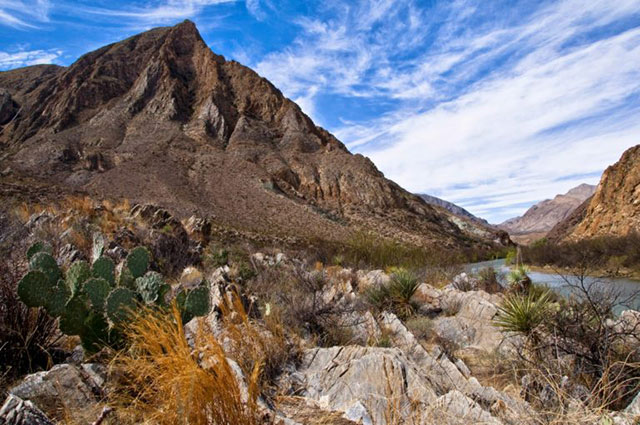 The Great Chihuahuan Desert, aka, Cactus Country, the locale for one of the early NAFTA legal battles involving the environment. (Photo by David Lauer licensed under the Creative Commons Attribution-Share Alike 2.0 generic license)
The Great Chihuahuan Desert, aka, Cactus Country, the locale for one of the early NAFTA legal battles involving the environment. (Photo by David Lauer licensed under the Creative Commons Attribution-Share Alike 2.0 generic license)
Whatever the specifics may be regarding Methalclad’s plans for rejuvenating the site, it is clear from the record that the company intended to expand upon it, planning to add 30,000 tons of toxic waste to the site over a 25-year period.
RAPAM’s Bejarano contends that bribery likely occurred on both sides, and major campaigns were held both in support and against the project. But regardless of these details, Methalclad moved forward without a municipal permit and began constructing new storage cells at the site. Local environmental groups in San Luis Potosí brought Greenpeace Mexico onboard, gaining national attention. As the site was located in the Grand Chihuahuan Desert — known as ‘cactus country’ for housing more than one-third (500 plus) of the world’s known cacti species — the idea to create a natural preserve including the disputed site seemed like a smart strategy for warding off the project.
The resulting back-and-forth dragged on for years, with final settlement coming in October 2001. Mexico was ordered to pay US$15.6 million plus interest in damages for breaching NAFTA Article 1105’s “minimum standard of treatment”. The Tribunal ruling on the settlement — made by a secretive panel far removed from the public eye of Mexico’s courts — called the ecological preserve decree “tantamount to expropriation” without compensation.
At the same time Methalclad and parties were battling it out, the system was beginning to spread new roots. Another 14 NAFTA-based ISDS cases were brought against Mexico, though with no major settlements. And in Canada 8 cases were filed, three ending in awards totaling nearly US $16 million. According to the experts, at this point the international investment arbitration floodgates had been opened. And everyone except lawyers, arbitrators, and corporations stood to suffer in the resulting legal tsunami.
NAFTA Disputes Heat Up and Head North
In 1997, Canada lost its first NAFTA ISDS case, when a preliminary Tribunal sided with US chemical company Ethyl Corporation, forcing the Canadian government to repeal their ban on the import and interprovincial trade of the gasoline additive MMT, a manganese-based alleged neurotoxin. Canada was forced to pay the company US$13 million and offer a formal apology.
This might seem like an open and shut case of investor profit winning out over environmental protection, but Weiler again cautioned that the suit demands a closer look, noting that corruption and politics played a role.
Methylcyclopentadienyl Manganese Tricarbonyl, or MMT, helps raise the octane levels of unleaded gasoline, making combustion more efficient. Weiler explained that MMT was introduced to the market to help meet air quality commitments, but that the additive didn’t work well in the Cadillac convertors of vehicles made in Ontario and Quebec. As a result, provincial governments pressured the federal government to impose bans on the additive, citing concerns over MMT’s interference with onboard diagnostics and potential environmental contamination.
The true range of motivations behind the ban and resulting lawsuit are likely unknown to even those directly involved — so too then is the outcome. In one light, the Tribunal’s decision can be seen as an embarrassing environmental and democratic defeat for Canada, leading to the repeal of a ban imposed at least in part to negate environmental risks. In another light, their decision can be perceived as a stand against violations of national treatment and expropriation without compensation.
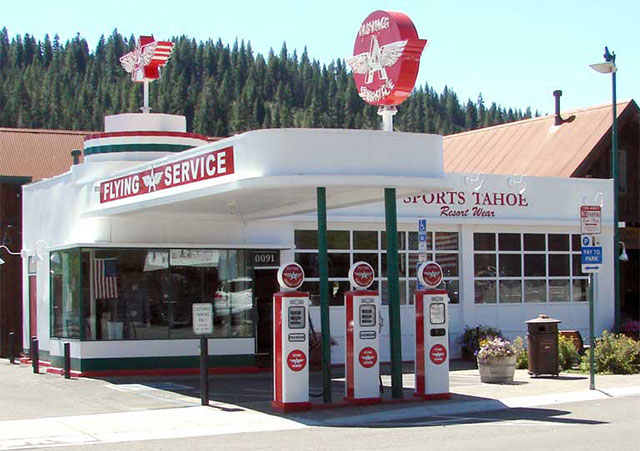 When Ethyl Corp. tried to introduce gasoline additive MMT to the California market, many mom-and-pop style gas bars still existed in parts of the state, with aging storage tanks. This restored “Flying A” station in Truckee, California, has been transformed into a clothing store. (Photo by Don Graham licensed under the Creative Commons Attribution-Share Alike 2.0 generic license)
When Ethyl Corp. tried to introduce gasoline additive MMT to the California market, many mom-and-pop style gas bars still existed in parts of the state, with aging storage tanks. This restored “Flying A” station in Truckee, California, has been transformed into a clothing store. (Photo by Don Graham licensed under the Creative Commons Attribution-Share Alike 2.0 generic license)
Whatever the truth, after the ruling Canadian officials were likely a little worried. Since 1995 another cat-and-mouse litigation game with American company S.D. Meyers Inc. had been brewing out west.
S.D. Meyers Inc., an Ohio family run business, had developed a new method to chemically declorinate PCB toxic waste, reclaiming far more metal, wood pulp, and oil than traditional burning techniques. But politicians put an end to the company’s prospects, ultimately protecting Canadian business interests.
Weiler said the major conflict was with Swan Hills, an Albertan company that after Meyers started to shop around in the region decided they wanted to get in on the lucrative, untapped PCB waste disposal market. The Canadian government took emergency measures to shut down the cross-border transfer of PCBs, citing the terms of the Basal Convention, which technically allowed the transport of the chemical waste for repatriation purposes.
“Not only was this unfair treatment towards Meyers, in the end, the waste processed at Swan Hills was done so using the simple toss and burn method. A huge, potentially far more environmentally sound industry [as proposed by Myers] was shutdown permanently,” said Weiler. “This was an especially sad story for Canadian environmentalism.”
Though they didn’t get as much as they were asking for — US$20 million — a Tribunal awarded Meyers CA$6.05 million plus interest, citing the same violations as those in the Ethyl case.
Meanwhile, another major environmentally based legal battle was underway in western Canada, though that suit never made it to ISDS arbitration. Back in 1993, US Sun Belt Water Inc. and its Canadian partner company had sued the province of British Columbia in Canadian court, seeking US $50 million in damages over British Columbia’s water protection legislation and moratorium on bulk water exports.
In 1996, Canada settled with Sun Belt’s Canadian partner company in court for an undisclosed amount, while US Sun Inc. went forward and filed a Notice of Intent via NAFTA Chapter 11 provisions (once the agreement was ratified), seeking US $10.5 billion in damages. While the claim is currently listed as inactive, the sheer size and scope of the possible financial, environmental, and democratic repercussions of Sun Belt’s suit are grounds for deep concern.
From the available documents, plus a few expert accounts, it appears that political and corporate corruption played a role in shaping today’s ISDS system, as legal teams tested ingenious new interpretations of Chapter 11 provisions to target issues not typically viewed as trade barriers, such as public and environmental policy. And, according to the experts and the record, the system is still in a state of flux, with the number of cases filed expanding annually at a fairly steady rate.
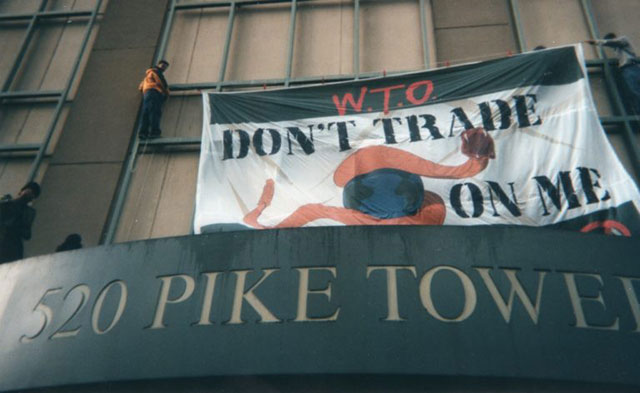 Protesters put up a sign at a 1999 WTO protest in Seattle, Washington. (Photo by Ph0kin licensed under the Creative Commons Attribution-Share Alike 2.0 generic license)
Protesters put up a sign at a 1999 WTO protest in Seattle, Washington. (Photo by Ph0kin licensed under the Creative Commons Attribution-Share Alike 2.0 generic license)
Scott Sinclair compiled a review of NAFTA Chapter 11 Investor-State Disputes for the Canadian Centre for Policy Alternatives last spring, detailing the 77 known cases prior to January 1, 2015. He recorded 35 cases against Canada, totaling CA $172.7 million, and 22 cases against Mexico totaling US $204.2 million.
To date, 21 cases have been filed against the US government, yet it has never lost a case, or for that matter, even had to settle out-of-court. Canada has (officially) lost 3 cases, settled 6 out-of-court, and has 9 ongoing cases. Mexico has lost 5 Chapter 11 suits, settled none in court and has 2 ongoing trials. Of the 77 cases reviewed, Sinclair found 20 directly involved natural resources and 18 challenged government’s environmental protection measures.
“Canada has a long history of being sued under NAFTA provisions, [but that’s a history] very much still being written,” explained Sinclair. “Though we were initially told we needed these [NAFTA ISDS] stipulations of investment law to protect investors from corruption in Mexico, to date, Canada is the most sued country under the terms.”
Sinclair’s assessment also found that in the years following the long-awaited final award or settlement of major cases from the mid-to-late 1990s, the costs to countries have soared and Canada is seriously losing the battle. Since 2005, 70 percent of new cases have been brought against Canada — totaling US $9 billion.
NAFTA Bites the US: Turnabout Is Fair Play
According to NGO experts like Carroll Muffett with the Center for International Law, the first dispute case to really stoke environmentalists’ into action came ironically against the country that threw most of the early NAFTA punches. While the US was the subject of two potential arbitrations in 1998 and 1999, both cases were dismissed.
It wasn’t until June of 1999, when Canadian chemical company, Methanex Corporation challenged California’s phase-out of gasoline additive MTBE — a chemical that had contaminated parts of the state’s surface and groundwater supply — that the charges stuck.
At the time, many mom-and-pop gas stations were still operating in California, often with older in-ground tanks prone to leakage. That being so, an outright MTBE ban seemed like the state’s best choice, explained Martin Wagner, Earthjustice’s managing attorney.
 A WTO protest in Jakarata, Indonesia. NAFTA lawsuits that benefited corporate profits at the expense of democratic institutions and environmental regulations helped trigger global resistance to other international trade agreements. (Photo by Jonathan McIntosh licensed under the Creative Commons Attribution-Share Alike 2.5 generic license)From a legal standpoint, it made sense to simply ban the polluting chemical, as opposed to replacing every aging tank and then monitoring them for leaks forever, “But from a manufacturer’s [profit] standpoint, the decision sucks,” Weiler bluntly explained.
A WTO protest in Jakarata, Indonesia. NAFTA lawsuits that benefited corporate profits at the expense of democratic institutions and environmental regulations helped trigger global resistance to other international trade agreements. (Photo by Jonathan McIntosh licensed under the Creative Commons Attribution-Share Alike 2.5 generic license)From a legal standpoint, it made sense to simply ban the polluting chemical, as opposed to replacing every aging tank and then monitoring them for leaks forever, “But from a manufacturer’s [profit] standpoint, the decision sucks,” Weiler bluntly explained.
Methanex sought damages of $970 million, but their plan massively backfired. After six years, the NAFTA dispute Tribunal dismissed the company’s claims and ordered them to pay the US government’s legal fees — some $3 million—plus the undisclosed full cost of arbitration. In the end, the case was dismissed, but it wasn’t thrown out on environmental or civil society grounds, said the experts.
“Methanex lost simply because they couldn’t properly prove NAFTA provisions had been breached,” said Weiler. “But at the time I remember thinking the whole matter was a bit scary. It seemed like environmental standards were being [threatened for] a manufacturer’s benefit.”
While a full telling of NAFTA suits brought to date is too long, complex, and in many instances, poorly publically documented to be reported here, Sinclair and others said they have uncovered a disturbing overall trend: aside from the rapidly rising number of dispute cases annually, cases increasingly involve the environment.
When asked which case Sinclair found the most alarming, his answer matched that of nearly every NGO expert interviewed for this series: Clayton and Bilcon of Delaware Inc. v. Government of Canada..
“To me Bilcon is probably the most disturbing decision of the many [NAFTA ISDS dispute] cases I’ve followed because the Tribunal found fault with environmental assessments and decisions made by both the provincial and federal government,” said Sinclair. “The repercussions of this are heavy and long-lasting and whatever winds up happening from here on out, at this stage we can’t really call any outcome a win.”
NAFTA Goes Nuclear: Clayton/Bilcon v. Canada
The Canadian province of Nova Scotia is aptly called an ocean playground — it’s written right on their license plates — and eco-tourists and researchers alike from all over the world come to admire the region’s pristine ecosystems and species now scarce elsewhere, like the Near Threatened piping plover (Charadrius melodius), Vulnerable Ram’s-head lady slipper (Cypripedium arietinum), and Endangered Blanding’s turtle (Emydoidea blandingi)
Many of Nova Scotia’s marine biodiversity hotspots have been safeguarded by their remote nature, not to mention long-standing government protections. The Digby Neck region, the skinny southwestern tip of the province, is of particular ecological importance; the seasonal home to dozens of imperiled species like the Endangered Right whale (Eubalaena glacialis), the Vulnerable Atlantic puffin (Fratercula arctica), plus dozens of other migrant marine mammals, fish, and birds.
In the spring of 2002, the Nova Scotia Department of Environment and Labor gave permission for Nova Stone Exporters Inc. to operate a 3.9-hectare (~ 9 acre) quarry at Whites Point, Little River on the Digby Neck.
The following winter the Clayton family and Bilcon Inc. of Delaware formally proposed a massive expansion of the quarry, to some 120-hectare plus (nearly 300 acres), as well as the construction of a huge accompanying marine terminal to help ship product.
 A typical scene in the tiny port of Little River, Nova Scotia. Bilcon’s plans were proposed in the community and subsequently rejected on a federal and provincial level for violating “core community values,” among other concerns. The government of Canada now stands to foot the bill for the repercussions of this decision, facing a US $101 million award settlement under NAFTA. (Photo by Rose licensed under the Creative Commons Attribution-Share Alike 2.0 generic license)
A typical scene in the tiny port of Little River, Nova Scotia. Bilcon’s plans were proposed in the community and subsequently rejected on a federal and provincial level for violating “core community values,” among other concerns. The government of Canada now stands to foot the bill for the repercussions of this decision, facing a US $101 million award settlement under NAFTA. (Photo by Rose licensed under the Creative Commons Attribution-Share Alike 2.0 generic license)
Bilcon claimed they intended to use this quarry for 50 years, until the extracting and shipping of the basalt became too inefficient to be profitable. However sources intimately familiar with the region, and the Whites Point quarry in particular, said that it was clear that the company’s basalt business would become unprofitable in a matter of a few years.
These experts instead assert that the real profit was not in the quarry, but in the construction, operation, and potential sale of the marine terminal which would be predominately staffed by relocated American and foreign-contracted workers. The terminal as envisioned would have drawn large cargo and container ships from around the world to an area previously untouched by such large-scale human disruptions.
Clayton/Bilcon’s 2003 expansion-application triggered a mandatory Environmental Assement (EA), resulting in the formation of a Joint Environmental Assessment Panel run by the Federal Canadian Environmental Assessment Agency (the since dissolved CEAA) and the Nova Scotia Department of Environment and Labor.
In an early press release, both the federal and provincial ministers praised the choice of the Joint Panel review. But from the start, there was a great deal of public concern over the potential negative impacts of the project regardless of the panel’s findings — fears that didn’t dissipate as more details came to light, according to Marine and Environment lawyer Meinhard Doelle, who offered legal advice to Whites Point assessment intervenors and who was an independent witness before the Whites Point Panel.
The Joint Panel, with the aid of public comment, released the guidelines for how an Environmental Impact Statement (EIS) would be prepared for Whites Point in the winter of 2005 — and that’s where an otherwise transparent process turns murky.
In this case, the project proponent bore the responsibility of providing the necessary data and information for the EIS. Thus, Bilcon themselves took on the cost of completing the statement, but also thereby maintained a high level of influence over its preparation and content.
Bilcon supplied the Joint Panel with an EIS that found no adverse environmental impacts that would exceed accepted thresholds without minor mitigations, such as relocating the marine terminal site to lessen the impact on shore fish stocks.
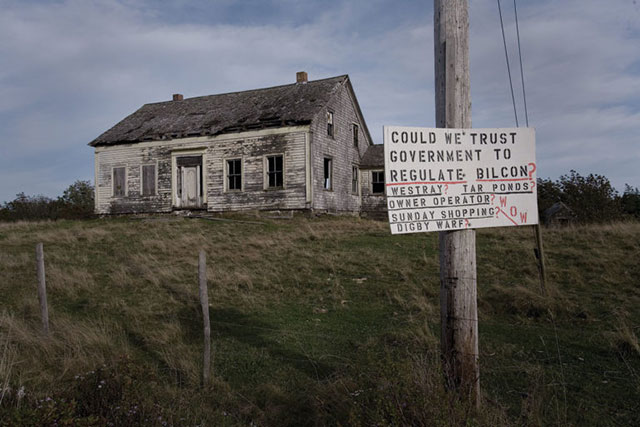 A protest sign sits in front of an abandoned home in rural Digby, Nova Scotia. During the five-plus years that the environmental assessment was being conducted on the project, signs such as these, mostly against, but some in support of, Bilcon’s plans, littered the otherwise quiet rural region. Today, some of these signs still stand, as the NAFTA Tribunal’s award has yet to be finalized. (Photo by Russel Monk licensed under the Creative Commons Attribution-Share Alike 2.0 generic license)
A protest sign sits in front of an abandoned home in rural Digby, Nova Scotia. During the five-plus years that the environmental assessment was being conducted on the project, signs such as these, mostly against, but some in support of, Bilcon’s plans, littered the otherwise quiet rural region. Today, some of these signs still stand, as the NAFTA Tribunal’s award has yet to be finalized. (Photo by Russel Monk licensed under the Creative Commons Attribution-Share Alike 2.0 generic license)
After years of public comments and hearings, and intensified campaigns on both sides — but predominately against — the Whites Point project, the Joint Panel released their assessment in October of 2007. The report revealed what had become apparent in the five-year review process: Canadians, in particular the residents of Digby Neck and the surrounding islands, were unwilling to accept the venture because of the clear risks to the environment and their livelihoods.
The public and Joint Panel also voiced grave doubts regarding the integrity of Bilcon’s EIS, despite the drawn out periods of public consultation, revisions, and additional information provided by the company, revealed Doelle.
The Panel — just as Bilcon’s EIS — did not cite the biophysical impacts of the Whites Point project as likely to surpass acceptable thresholds without mitigation. Instead the Panel concluded: “the Project would have a significant adverse effect on a Valued Environmental Component represented by the ‘core values’ of the affected communities.” The Joint Panel wrote that local engagement had convinced it of an exceptionally strong and well-defined public vision of the region’s future.
“The proposed injection of an industrial project into the region would undermine and jeopardize community visions and expectations, and lead to irrevocable and undesired changes of quality of life. In addition, the Project would make little or no net contribution to sustainability…. Based on an analysis of the benefits and burdens of the Project, the [Joint] Panel has concluded that the burdens outweigh the benefits and that it would not be in the public interest to proceed with the Whites Point Quarry and Marine Terminal development.”
The Panel went on to recommend federal and provincial authorities reject Bilcon’s construction plans, which by the end of 2005, they did.
 Shuckers do their work in front of eagerly awaiting customers during Digby’s famous Scallop Days Festival. (Photo compliments Canada Explore licensed under the Creative Commons Attribution-Share Alike 2.0 generic license)
Shuckers do their work in front of eagerly awaiting customers during Digby’s famous Scallop Days Festival. (Photo compliments Canada Explore licensed under the Creative Commons Attribution-Share Alike 2.0 generic license)
In February 2008, William Ralph Clayton et al. and Bilcon of Delaware, Inc. submitted their Notice of Intent to Submit a Claim to Arbitration. By May, they served a Notice of Arbitration, seeking US $101 million in damages. Bilcon claimed that the governmental environmental assessment, and the manner in which Canada’s environmental regulatory regime was applied to the project, was conducted in an arbitrary, unfair and discriminatory manner. In ISDS terms, this translates to a breach of three articles: 1102 (National Treatment), 1103 (Most-Favored Nation Treatment), and 1105 (Minimum Standard of Treatment).
In March of 2015, a Tribunal found Canada liable for breaching NAFTA Article 1105(1) and 1102. The process has now moved to the damages phase, where the final award will be decided.
In a blog post, Doelle writes that his personal knowledge of the decision gave him a chilling glimpse into the workings of the ISDS dispute system: “The insight this unique situation has provided me into the work of this NAFTA Chapter 11 challenge is nothing short of frightening. I found a NAFTA Tribunal that lacked, with the exception of [one] dissenting member, even a basic understanding of the legal context within which the decisions it was asked to rule on were made.”
Bilcon claimed in its suit that the Joint Panel failed to follow a legitimate process meeting ‘minimum standards of treatment’ and was ‘discriminatory,’ under NAFTA, said Doelle. He feels there was no evidence to indicate this claim, and notes that the Panel members were all distinguished members of the environmental community who were making their assessments with the good of the country, community, and the environment in mind. Citing legal reasons, the members of the panel, who responded to a Mongabay query, were unable to discuss their work or the resulting lawsuit.
All but one expert interviewed for this article agreed that the basis of Bilcon’s suit — the idea of fair or ‘minimum standard of treatment’ — now forms the basis for most current-day ISDS disputes. So it is worth exploring this concept more deeply.
Exploiting the Power of Vague Language
One of the major problems with ISDS arbitrations past and present, is the failure to clearly define legal terms, especially how the Tribunals interpret Article 1105, the ‘minimum standard of treatment’, said Chris Wold, who both works in the field and helps train the next generation of legal advocates as Director of the International Environmental Law Project at Lewis & Clark Law School. “Over time the definitions of ‘discrimination’ and ‘expropriation’ have become more clear and consistent, but the meaning of ‘minimum standard of treatment’ can go from black to white, case to case,” he explained.
“We started out [pre-NAFTA] with rather logical, clear violations cited in ISDS cases, such as expropriation, ” said Melinda St. Louis, Director of International Campaigns for Public Citizen. “Today the [legal] arguments [have] evolved to include far more confusing, complex, and odd scenarios. And lawyers, as they see fit, get the right to rewrite the definition of the terms [on a case-by-case basis].”
One way an ISDS Tribunal may determine ‘minimum standard of treatment’ is by comparing the case under consideration with past projects. Bilcon, for example, to prove their case, cited what they claimed to be comparable projects, said Doelle. But the example projects Bilcon used weren’t comparable or as stringently assessed as in the Whites Point case.
Doelle explained that it’s very hard to do a proper comparison of environmental assessments and impact statements in this instance because each project reviewed was so markedly different from another. In his view, a proper comparability assessment involves first defining basic apples to apples criteria for comparison: “Should all quarries be treated the same? [Should all similarly-]sized projects be treated the same? I would say the comparisons they [Bilcon] used were quite superficial,” Doelle said.
A federal or provincial court would have used case law to determine the validity of Bilcon’s case and claims, but ISDS Tribunals don’t work by the standards, definitions, or precedent of any nation’s legal system.
Sinclair agreed with Doelle, noting that Bilcon’s so-called comparable projects differed from Whites Point so drastically that it wasn’t, “logical to equate differing treatment between differing projects as unfair treatment or discrimination.”
The Tribunal concluded that the Joint Panel’s recommendation against the project applied a standard of “core community values” not found in Canadian law and cited a lack of due process, claiming Bilcon wasn’t given the chance to make a proposal including this standard.
However, experts pointed out that the “core community values” standard is included in provincial law, which makes the Tribunal’s ruling problematic in the sense that it overturns public policy and domestic environmental law. Critics said that in this case, the government’s sovereign right to rule was overthrown by a corporation’s right to profit.
Nova Scotia’s environmental assessment standards clearly define the environment as including social-economic impacts. Therefore, the long list of likely environmental, social, and economic outcomes resulting from the construction and operation of a huge marine terminal and quarry were viable legal grounds for the project’s rejection all on their own.
The Joint Panel had indeed applied these standards as determined by provincial law. The Whites Point Panel decision closely considered the potential negative socio-economic impacts, chiefly from the marine terminal’s effect on the region’s historic fishing and tourism industry. Digby scallops, lobster, and haddock are prized by chefs and seafood-lovers worldwide, often fetching top-dollar domestically and abroad. And unlike many of the globe’s historic fishing grounds, the local fishing industry’s value was actually increasing at the time, thanks to early government and community environmental intervention. After decades of decline, monitoring had shown that the local fish landings in Digby Neck and around the region had experienced a more-than doubling in total value from 1998 to 2004, jumping from $14.8 million to $22.9 million (a 55 percent increase) as populations stabilized.
Another factor that made the project so unappealing to the local community was the work force necessary to construct and then operate the terminal and quarry. The bulk of these proposed workers were rumored to be foreign, either relocated Americans or workers from visiting vessels. In other words, the local workforce would have benefited minimally from the project.
A February 2006 economic profile completed for Bilcon found Digby Neck had an unemployment rate of 14.4 percent in 2001, some 30 percent higher than the provincial average. The same report estimated that at the time an annual average of 43,000 tourists visited the Digby Neck and Islands, a number which placed tourism second only to fishing in the local economy.
The Tribunal, however, appears to have paid no attention to the potential negative impacts Bilcon would have had on local livelihoods, tourism, or the regional fishing economy.
In Doelle’s blog he writes: “as the [one dissenting Tribunal member] points out, ‘core community values’ was not a methodology or a test, but rather was a phrase the Whites Point [Joint] Panel developed to summarize its conclusions about the socio-economic effects of the project.”
Doelle added that, “the fact that the Whites Point project underwent a panel review in my opinion really had nothing to do with the fact Bilcon was a foreign investor, [but] rather [that the firm showed] a lack of constructive company engagement with the local community.”
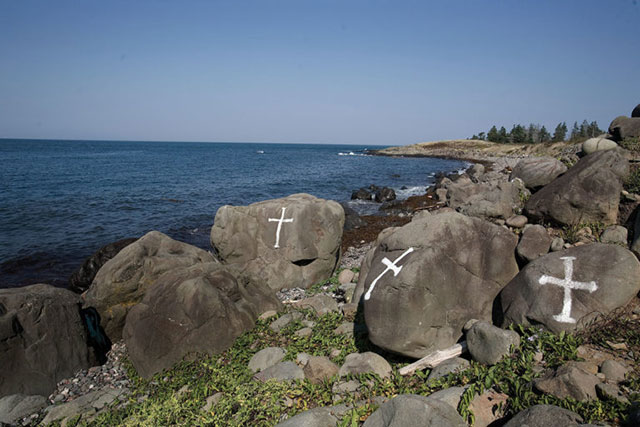 Crosses painted on rocks near the proposed Bilcon marine terminal site. The local community protested loudly against Bilcon’s quarry and industrial seaport proposal. (Photo by Kemp Stanton licensed under the Creative Commons Attribution-Share Alike 2.0 generic license)
Crosses painted on rocks near the proposed Bilcon marine terminal site. The local community protested loudly against Bilcon’s quarry and industrial seaport proposal. (Photo by Kemp Stanton licensed under the Creative Commons Attribution-Share Alike 2.0 generic license)
Sinclair said that by his estimation, Bilcon had been careless in its planning of the project, noting that, as an established company, it should have been well aware of the perils of investing in such a huge natural resource project, especially one of the sheer size, scope, and at the famously sensitive ecological location where the company pitched its tent.
Bilcon, he said, should have investigated the terms of provincial assessments in advance, terms that clearly gave the province the right to reject projects based on socio-economic factors. Aside from these more foreseeable challenges, the company faced a wall of resistance, with the region’s communities actively fighting to prevent the project from going forward every step of the way. Sinclair concluded that if Bilcon honestly hadn’t seen the rejection coming, he’d be shocked.
“I do agree that the Nova Scotian government had encouraged the investor in this case to develop the project [at the start] and then in some ways, slowly pulled the rug from under them,” said Sinclair. “But to then go after the whole country for millions of dollars in compensation is completely inappropriate. They had the same legal options as every one else [to take the case to the provincial or state courts], but [instead] chose a special [NAFTA Tribunal] not only unavailable to Canadian citizens, but out of the reach of domestic congress as well.”
In June 2015 Canada filed a Notice of Application with the Federal Court of Canada requesting that it negate the upcoming US$101 million Bilcon award, citing that the Tribunal exceeded their jurisdiction and that its decision conflicted with Canadian public policy.
As such, the terms of the final award are yet to be actually set, or at least released to the public. Trade experts agree that it’s hard to know how the case will finally turn out. But based on precedent, Canada is unlikely to get out of paying at least some form of damages under the authority of NAFTA’s Chapter 11.
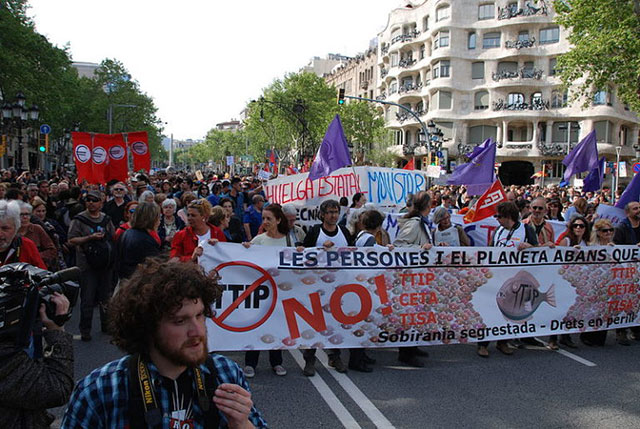 Public outrage over NAFTA dispute resolutions favoring corporations over people and the environment helped catalyze opposition to other trade agreements. A protest in Barcelona, Spain against the still being negotiated TTIP. (Photo by horrapics licensed under the Creative Commons Attribution 2.0 Generic license)
Public outrage over NAFTA dispute resolutions favoring corporations over people and the environment helped catalyze opposition to other trade agreements. A protest in Barcelona, Spain against the still being negotiated TTIP. (Photo by horrapics licensed under the Creative Commons Attribution 2.0 Generic license)
Beyond Bilcon
Though the environmental assessment systems used at Whites Point were overhauled in 2012, the final ruling in the Bilcon case could still pose major challenges to Canada’s future right to choose, and ability to protect previously established environmental protections.
Upholding Bilcon’s award would at the very least seriously threaten a hard-won community environmental victory. Worst-case scenario: the ruling could bring changes to Canada’s environmental assessment processes, likely diluting their power.
Jessica Seguin with Global Affairs Canada wrote in response to a series of questions regarding the case: “Canada will continue to regulate in the public interest, including to protect the environment, while respecting trade agreement obligations. A NAFTA tribunal cannot compel the government to amend its laws and regulations or change its policies. It can only order the payment of compensation for damages in the event a Party is found to have violated Chapter 11 (i.e. the investment chapter).”
Sinclair argued that the Tribunal made a judgment that went beyond its authority by finding that the Joint Panel did not follow Canadian law in how it conducted its review, and in its recommendation to reject the quarry/terminal project. He said Bilcon had the right to take their case to federal or provincial court, and should have, but instead chose to go straight to international arbitration.
“The [Tribunal] interpreted and then ruled on a Canadian law, despite the fact they’re not entitled to make that call,” said Sinclair. “If the ruling stands, it will cast a detrimental chill over all future environmental assessments and those conducting them will have to be constantly looking over their shoulder, waiting for more unforeseen and likely, scary, obstacles.”
If the award sum stands it will be financed by Canadian taxpayer’s money, Sinclair added, meaning that NAFTA’s Chapter 11 provisions have become a conduit by which corporations can lay claim to large sums of public money.
Wold contended that a ruling in favor of Bilcon and the NAFTA Tribunal would be a ruling in favor of national “outsiders,” and would have a serious chilling effect on democracy, the rule of law, and the environmental standards that have been built up by developed nations over many decades.
“Some people classify the trade dispute system as against the environment and [action on] climate change, but I think the scope of issues the system can rule on makes it ultimately against sustainable development, making it difficult to adapt and maintain sustainable models,” said Wold.
In other words, the standards used by the NAFTA Tribunal to decide cases tend to favor existing industries and large corporations — such as fossil fuel or mining companies — along with the traditional investors who can not only afford to get into these industries but fund banks of trade lawyers, rather than supporting up and coming small companies promoting alternative technologies.
Likewise, the ISDS Tribunals give investors a carte blanche insurance policy: multi-national companies can now go into a country and make outlandish demands that a government waive its environmental regulations and allow development of its natural resources, while disregarding the wellbeing of that nation’s people, all in the name of profit. If the nation resists, the firm can bypass the country’s court system, and sue for billions using a NAFTA ISDS Tribunal. In this scenario the investor stands a good chance of winning financially whether the project is completed or not.
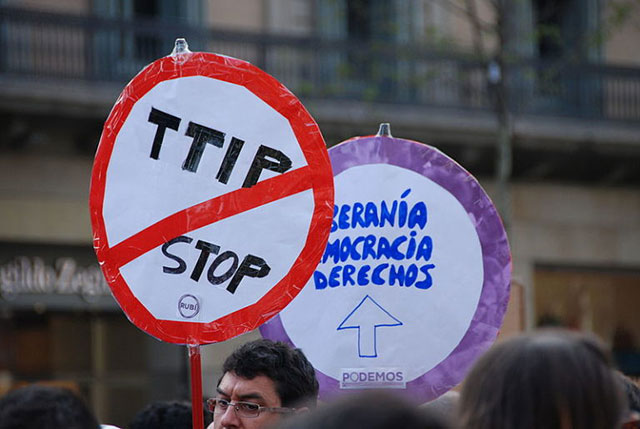 Public opposition to NAFTA and a host of proposed international treaties such as the TTP, TTIP and TISA have continued to intensify. This protest is in Barcelona. (Photo by horrapics licensed under the Creative Commons Attribution 2.0 Generic license)
Public opposition to NAFTA and a host of proposed international treaties such as the TTP, TTIP and TISA have continued to intensify. This protest is in Barcelona. (Photo by horrapics licensed under the Creative Commons Attribution 2.0 Generic license)
Weiler said that from a lawyer’s perspective, the sensationalism and media coverage of early NAFTA cases got the attention of trade lawyers worldwide: “Firms [now] saw a chance to make big bucks advising politicians, governments, and investors on this new and confusing [dispute arbitration] system,” he said. “When I began, few knew the topic even existed. Today you’d be hard pressed not to find a whole department of big firms set aside only to handle ISDS [cases].”
“After NAFTA, there was an explosion of cases mainly because the [ISDS] system had become a process center for lawyers, especially in D.C.,” said St. Louis. “And each new interpretation of the laws opens the system to new types of lawsuits. I honestly don’t think even the people who came up with the [Chapter 11] provisions had any idea things would get this out of hand.”
As St. Louis and other experts make clear, neither ISDS nor NAFTA’s Chapter 11 provisions were meant to create the high-stakes game rigged hugely in favor of corporations that is the modern-day ISDS arbitration process. Instead, nuances and interpretations of language, human error, clever lawyers, and ultimately, greed transformed what began as a basic investor protection tool into a weapon of massive financial, environmental, and democratic harm.
Truthout Is Preparing to Meet Trump’s Agenda With Resistance at Every Turn
Dear Truthout Community,
If you feel rage, despondency, confusion and deep fear today, you are not alone. We’re feeling it too. We are heartsick. Facing down Trump’s fascist agenda, we are desperately worried about the most vulnerable people among us, including our loved ones and everyone in the Truthout community, and our minds are racing a million miles a minute to try to map out all that needs to be done.
We must give ourselves space to grieve and feel our fear, feel our rage, and keep in the forefront of our mind the stark truth that millions of real human lives are on the line. And simultaneously, we’ve got to get to work, take stock of our resources, and prepare to throw ourselves full force into the movement.
Journalism is a linchpin of that movement. Even as we are reeling, we’re summoning up all the energy we can to face down what’s coming, because we know that one of the sharpest weapons against fascism is publishing the truth.
There are many terrifying planks to the Trump agenda, and we plan to devote ourselves to reporting thoroughly on each one and, crucially, covering the movements resisting them. We also recognize that Trump is a dire threat to journalism itself, and that we must take this seriously from the outset.
After the election, the four of us sat down to have some hard but necessary conversations about Truthout under a Trump presidency. How would we defend our publication from an avalanche of far right lawsuits that seek to bankrupt us? How would we keep our reporters safe if they need to cover outbreaks of political violence, or if they are targeted by authorities? How will we urgently produce the practical analysis, tools and movement coverage that you need right now — breaking through our normal routines to meet a terrifying moment in ways that best serve you?
It will be a tough, scary four years to produce social justice-driven journalism. We need to deliver news, strategy, liberatory ideas, tools and movement-sparking solutions with a force that we never have had to before. And at the same time, we desperately need to protect our ability to do so.
We know this is such a painful moment and donations may understandably be the last thing on your mind. But we must ask for your support, which is needed in a new and urgent way.
We promise we will kick into an even higher gear to give you truthful news that cuts against the disinformation and vitriol and hate and violence. We promise to publish analyses that will serve the needs of the movements we all rely on to survive the next four years, and even build for the future. We promise to be responsive, to recognize you as members of our community with a vital stake and voice in this work.
Please dig deep if you can, but a donation of any amount will be a truly meaningful and tangible action in this cataclysmic historical moment.
We’re with you. Let’s do all we can to move forward together.
With love, rage, and solidarity,
Maya, Negin, Saima, and Ziggy